Yves here. John Helmer provides a detailed and informative review of information about the Crocus massacre, focusing on accounts from the Russian side. One aspect that features prominently here, and as far as I can tell, has been neglected in Western reports, is the role of the fire and building collapse in the deaths and casualties. Helmer notes that the four shooters left before they’d gotten halfway through their ammo, suggesting they left to escape the blaze. There are also accusations in Russia that the theater was out of compliance with multiple fire-risk-reducing requirements, compounded by the use of cheap and particularly flammable Chinese materials.
By John Helmer, the longest continuously serving foreign correspondent in Russia, and the only western journalist to direct his own bureau independent of single national or commercial ties. Helmer has also been a professor of political science, and an advisor to government heads in Greece, the United States, and Asia. He is the first and only member of a US presidential administration (Jimmy Carter) to establish himself in Russia. Originally published at Dances with Bears
In just thirteen minutes, four Kalashnikov rifles, knives, and plastic bottles of gasoline, discharged by four men, were not enough to kill and injure so many people as have been accounted for to date in the Crocus City Hall attack in Moscow.
More than half those examined so far in post-mortems “died as a result of the fire from exposure to high temperature and combustion products”, according to Alexander Bastrykin, the chief investigator in his public report to President Vladimir Putin on Monday night. Post-mortems have yet to be reported for one-third of the 139 dead counted by Bastrykin; no analysis of the cause of injuries to 182 of the surviving casualties has been reported yet; 93 of them remain in hospital.
Bastrykin also reported “two AK-74 assault rifles, over 500 rounds of ammunition, 28 magazines with ammunition, and bottles with remaining gasoline were found and seized at the scene.” A NATO military expert explains: “They didn’t strike me as well-trained, so they lost time changing magazines and their fire wasn’t all that accurate. These data tell me the majority of victims died from some other cause than gunshot.”
Yevgeny Krutikov, a writer with military intelligence sources, reported in Vzglyad: “It can be assumed that the weapons were stored in the terrorists’ cache for a long time and not too carefully – the machine guns sparkled during the shooting. This indicates damage to the barrel or breech (dirt got inside the barrel).”
Recruitment of the shooters; pre-placement of weapons and ammunition; accommodation and advance payment to the gunmen; purchase of the car they used; communications and coordination; exit undetected in the crowds escaping the building; and the escape route to the Ukraine border through Bryansk region – the evidence of these details prepared over weeks and months indicate a much larger organization than the four shooters formed with seven others already arrested and under interrogation.
What they know and will tell is likely to reveal a sophisticated command-and-control system which knew how vulnerable the target was, how to maximize the killing in the shortest possible duration, and at the same time allow escape for the attackers – which is almost unprecedented in the recent history of mass terrorist attacks in Russia. .
That’s to say, the command knew — the shooters and their accomplices didn’t. There was advance reconnoiter of the Crocus City Hall so that the shooters knew the route they followed inside the building and then out under cover of fire and smoke, which erupted faster than they were able to shoot almost half of their ammunition which they left behind.
Did the command also know that Crocus City Hall and the surrounding mall were operating without adequate fire alarms, smoke and carbon monoxide detectors, sprinklers, and emergency ventilation, none of which has been reported by eyewitnesses? Was the building targeted because the command knew it was constructed without fire-resistant structural supports, allowing ceilings and roof to cave in, choking or crushing those beneath to death?
“Most of the victims in Crocus died not at the hands of terrorists, but from the criminal negligence of the owners and regulatory authorities,” reported Mikhail Delyagin, chairman of the State Duma Committee on Economic Policy, on Sunday evening. “It is known that many people suffocated with carbon monoxide inside the building. There are already more victims of this kind than those killed by terrorist shooting. Nothing like this could happen in a certified building built according to modern standards for such objects. Why? Because all such buildings are equipped with an automatic ventilation system. These are windows or hatches that fire off automatically if the detector detects an increased level of carbon monoxide inside. Holes open in the roof – and the life-threatening gas goes into the sky. This system works, by the way, without electricity, on compressed air.”
“The way the Crocus burned down shows that cheap Chinese materials (glass wool, plastics, cable braid, etc.) were used in its decoration, which are prohibited for use in public buildings. The reason for the ban? Combustibility. In Europe, non-burning glass wool, plastics, etc. have been used for a long time. They are, of course, twice or three times more expensive than the Chinese equivalent. But they have one advantage: they do not burn in case of fire. And they don’t kill those who are inside.”
Delyagin has publicly accused Aras Agalarov, the wealthy founder of the Crocus shopping and development group, and his son Emin of failing “to formally commission this particular concert hall. As it became known, it is not listed as a properly designed capital construction object on the cadastral map of the Federal Register. Apparently, the amount of bribes needed to receive such a dangerous object exceeded all reasonable limits, and for Agalarov, taking into account the above-mentioned monstrous violations of standards, it was cheaper to extend the status of a building under construction than to put it into operation.”
Bastrykin has announced “the investigation is checking the possibility of violation of safety requirements and the fire extinguishing system in the Crocus City Hall concert hall. For this purpose, remote controls, electronic components and control devices for the fire protection system of the concert hall were seized. They are aimed at researching and extracting information about the operating mode of fire safety systems at the time of the terrorist attack. The contents of the fire protection system server are being studied with the participation of experts. To establish the operability and timely operation of all fire safety systems, a fire technical examination has been appointed.”
Emin Agalarov has issued a press statement claiming he arrived before the gunmen had left. He said he “entered the building 40 minutes after the first shots were fired. He noted that the fire safety system was working and the doors were unlocked…The sprinkler fire extinguishing system was also operating normally. The building collapsed only six hours after the start of the terrible fire. Some rooms remained intact and did not burn down.”
“If we focus too hard on the minute details which are being patched together, this might clear up some details of assault,” comments a retired senior intelligence source in a position to know, “we might learn something more but not the fundamentals. These [the four shooters] are no ISIS-K. . The harder New York Times, BBC and The Guardian try to prove they are, the less we have to believe it. They are no jihadists. Just murderers. Mercenaries brought in a month ago.
They are not suicide killers. There are no reports of this ISIS outfit operating away from Afghanistan and Pakistan. Certainly not in Tajikistan. However there are mercenaries at a dime a dozen there who have fought all over. Including in ISIS.”
“At Ukraine entry, they would certainly have been killed, removing all the evidence. The investigation will show they were hired, paid for. A Tajikistan blogger news service reported raids in [Tajik] villages, but then removed it. I am sure their families and friends will be picked up and all connections to jihadists or contractors will be established. They are not migrants, do not speak Russian, and thus cannot claim any ethnic discrimination vendetta [against Russians].”
President Putin claimed in his meeting with the security services on Monday: “We know that the crime was perpetrated by radical Islamists. The Islamic world itself has been fighting this ideology for centuries. But we are also seeing how the United States is using different channels to try and convince its satellites and other countries of the world that, according to its intelligence, there is supposedly no sign of Kiev’s involvement in the Moscow terrorist attack, that the deadly terrorist attack was perpetrated by followers of Islam, members of ISIS, an organisation banned in Russia. We know whose hands were used to commit this atrocity against Russia and its people. We want to know who ordered it.”
What Putin meant by “radical Islamists” is unclear; the public evidence of the four individuals who have been charged has yet to confirm a record of their religiosity or any ideological conviction.
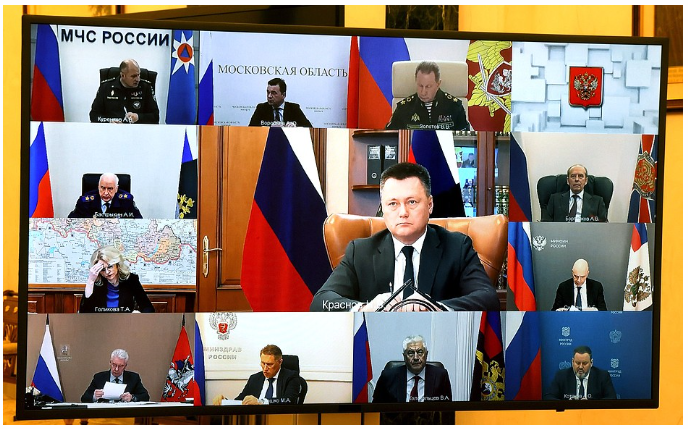
The officials at the Kremlin meeting on Monday: Prosecutor-General Igor Krasnov, Chief of Staff of the Presidential Executive Office Anton Vaino, First Deputy Chief of the Presidential Executive Office Sergei Kiriyenko, Deputy Prime Minister Tatyana Golikova, Presidential aide Maxim Oreshkin, Interior Minister Vladimir Kolokoltsev, Emergencies Minister Alexander Kurenkov, Minister of Labour and Social Protection Anton Kotyakov, Healthcare Minister Mikhail Murashko, Finance Minister Anton Siluanov, Director of the Federal Security Service Alexander Bortnikov, Commander of the National Guard Troops Viktor Zolotov, Chairman of the Investigative Committee Alexander Bastrykin, Moscow Region Governor Andrei Vorobiev, and Moscow Mayor Sergei Sobyanin. Source: http://en.kremlin.ru/
For the time being, the only evidence connecting the four shooters to the Ukraine is the direction they were taking when their vehicle was stopped by the security forces. In a shootout the car overturned, and three of the gunmen fled into the forest beside the road, leaving one man injured in the car.
The head of the State Duma Committee on Information Policy, Alexander Khinshtein, is the source for press reporting on the site of the interception. That was on Highway E101 about seven kilometres south of the P-120 intersection east of Bryansk city. From Bastrykin’s report, and from an award ceremony in Bryansk on Monday for the forces who made the capture – Federal Security Service (FSB), Interior Ministry, National Guard, and border forces of the Defense Ministry — the getaway was being tracked for some time before it reached the P-120 intersection. At that point, if the four men planned to head for Belarus, they would have turned right, followed the south circular road around Bryansk, and then turned left on to the A-240 towards the Belarus border, about 100 kms to the southwest.
Instead, the men drove due south and on the highway near Khatsun, they were about 100 kms from the Ukraine border. There have been reports they were expecting to make a rendezvous with accomplices they believed would guide them to safety over the Ukraine border, and to payday. Or, as Moscow sources speculate, to their execution by the Ukrainians.
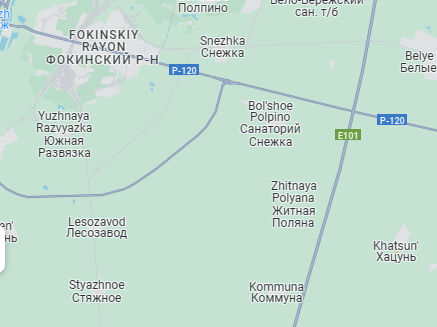
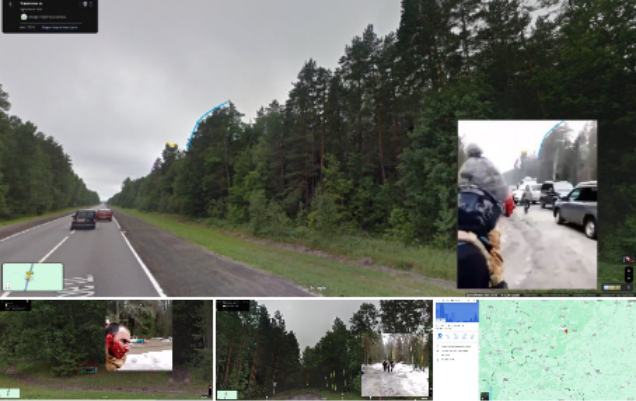
Above: Google map of the roads and villages, including Khatsun, east of Bryansk city. Below: the view in daylight of the point on Highway E-101 where the gunmen were intercepted about five minutes after they passed the Belarus turnoff, confirming to the security forces tracking the car that they were heading to the Ukraine.
Speculation, however, including analysis of the cui bono, who gains type, the sequence of statements from Washington, and the history of association between the US, British and Ukrainian secret services and Tajik mercenaries, creates a balance of probabilities, but not an explanation beyond reasonable doubt.
“Of course, we must also answer the question of why the terrorists, after committing their crime, attempted to flee specifically to Ukraine,” the president said at his meeting with security officials on Monday. “Who was waiting for them there? It is clear that those supporting the Kiev regime do not wish to be implicated in acts of terrorism and be seen as sponsors of terrorism. But there are indeed numerous questions.”
Public comments to reporters on Tuesday by the FSB chief Alexander Bortnikov and Security Council Secretary Nikolai Patrushev have answered with emphasis on the Ukrainians, backed by the US and UK.
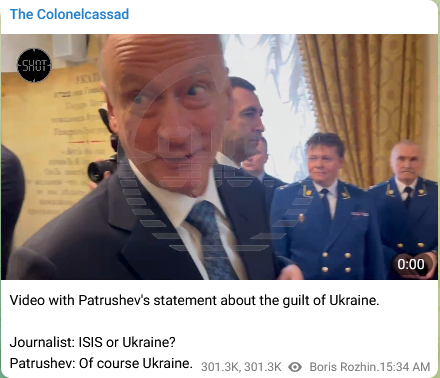
Source: https://t.me/s/boris_rozhin March 26 – 15:34.
Boris Rozhin (Colonel Cassad) has followed their remarks with a detailed statement of the history of the intelligence service operations before the Crocus attack, and a circumstantial detail of Ukrainian border drone operations in the area and on the night the getaway car was headed through Bryansk region. Click to read – March 26, Min 22: 23.
What is evident so far, including from the line of Tajik accomplices now making formal appearances in a Moscow court, is the absence of ideology or religiosity of the radical Islamic type; and ignorance of where their orders and money were coming from, and why. This non-evidence points to the Ukraine as strongly as the road the four shooters were taking when they were caught.
Their subsequent demeanour in brief videoclips after capture, in hospital, and in court confirms what the military blogger Boris Rozhin calls “dumb hysteria…behaviour [that is] typical in a situation where the actions of terrorists do not have a deep ideological basis. This is the case of the Crocus gunmen, where the sole motivation is only money. Already in the moment of flight, the criminals realized what they had committed and, since the terrorist attack was not supported by ideology, the militants were seized with animal fear for their own lives. Therefore, during the interrogation, they are ready to tell everything, cry and so on, just to stay alive.”
The Russian intelligence agency investigations now under way, according to Krutikov, are tracing the “Telegram accounts through which the terrorists received instructions, including during their departure from the crime scene. Most likely, it is this branch which directly links the investigation with the Ukrainian direction due to the indication of a specific square at the border crossing.”
The public recriminations against the Agalarov family are not supported by Alexander Kurenkov, the Emergencies Minister, who told the Kremlin meeting on Monday in a brief, ambiguous report: “The building was equipped with an automatic fire alarm system. This system responded to the fire as expected. There was also a set of four robotized fire-fighting hoses and a software control system, which worked in conjunction with other fire protection systems. They were activated during the terrorist attack, but the arson involved the use of flammable substances. According to experts, the system failed to extinguish the fire due to its wide spread. This is what I wanted to say. We managed to totally extinguish the fire on wall panels, given the materials they were made of, only at 6.40 pm today [March 25]. The search and rescue operations continue. They are expected to be completed by 5 pm tomorrow [March 26]. This concludes my report.”
An Emergencies Ministry (MChS) expert has released data indicating the fire covered 12,900 square metres and more than 900 cubic metres of collapsed structures were removed. In the videoclip the roofless exterior wall can be seen, and the destruction of the inner auditorium.
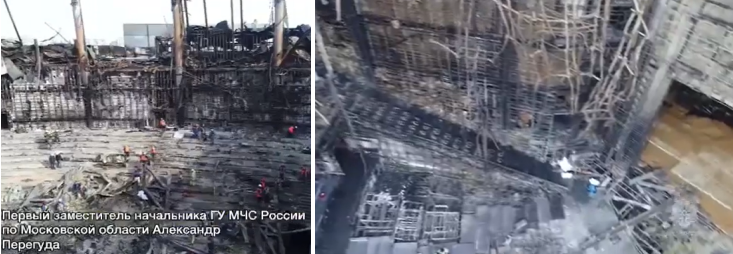
Source: https://www.kommersant.ru
A local fire brigade source comments: “this was a Category-5 fire — Class 5 is an extreme fire hazard — and the services did an extraordinarily professional job to contain and extinguish a fire of such intensity.” He said the roof “may have collapsed between 2:30 am and 3:30 am.” This corroborates Emin Agalarov’s report of the timing.
The fire expert explained: “If lots of fuel was spilled in the auditorium among the chairs with synthetic fabric and plastic elements, then even low-inflammable things could start burning. They are resistant to high temperatures, but not to extremely high ones. In this case the sprinkler system can be useless.”
The Moscow region governor, Andrei Vorobiev (Vorobyov), was at the site half an hour after the gang had left. “An operational headquarters has been established. All the details will come later.” At 10:39 on Saturday evening [March 23] he reported by video that the roof was still ablaze and that firefighters were pouring water on it from extension ladders.
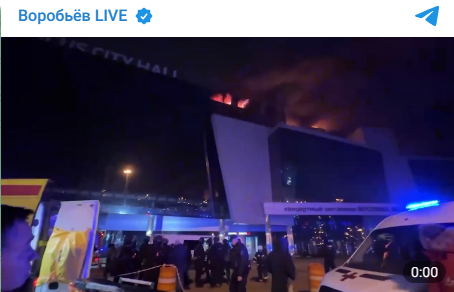
Governor Vorobiev is at lower left. Source: https://t.me/vorobiev_live/6164
Six hours later, at 04:43, Vorobiev posted a new video clip from inside the building in which he confirmed with firemen that the roof had fallen in. “The collapse of structures continues now,” Vorobiev reported. “There are still some pockets of fire, but most of the fire has been eliminated. Rescuers were able to enter the auditorium, where the temperature had been high for a long time and where, apparently, the epicentre of the fire was. The roof over the auditorium has collapsed, and the debris is still being dismantled.”

Source: https://t.me/vorobiev_live/6170
Delyagin was asked to say if he wished to correct his initial report and modify his allegations against the Agalarovs; he has not answered.
The political repercussions of the attack have been amplified in the Moscow media. But at a meeting of the Prosecutor-General’s Office Board on Tuesday, Putin played down his claim about “radical Islamists” of the day before. “As you know,” he said, “the perpetrators responsible for this mass murder have been arrested, and our law enforcement agencies are diligently investigating the circumstances surrounding this barbaric crime. They are piecing together the details of the attack, determining the roles and culpability of each individual involved, and analyzing the findings provided by criminalists and experts. The Federal Security Service [FSB], alongside other intelligence services, is actively addressing pertinent issues in coordination with the National Anti-Terrorism Committee.”
The president added: “I trust that the prosecutors, within the scope of their authority, will ensure that justice is served when charging the accused and during the legal proceedings.” This appears to be a response to western media reports that the four gunmen were beaten up and tortured after their capture.
Prosecutor-General Igor Krasnov said to Putin: “These atrocities have a common goal – to intimidate people, to destroy the unity of our people. Their performers, customers and curators will inevitably be punished. That is why the most important task for Russia remains to achieve the goals of a special military operation.” Putin had said the same thing the day before: “Their goal, as I mentioned, is to sow panic in our society while demonstrating to their own people that not all hope is lost for the Kiev regime. All they need to do is follow the orders of their Western patrons, fight until the last Ukrainian, obey Washington’s commands, endorse the new mobilization law, and form something resembling a new version of the Hitler Youth. To comply with all of this, they will seek new weapons and additional funds, much of which will likely be embezzled and, as is customary in Ukraine today, put into their own pockets.”
As more time has elapsed and the interrogations of the attack group have produced no new official evidence, the Russian media have been publishing angry calls to restrict migration into Russia, both legal and illegal; attacks on ethnic communities like the Tajiks; and on the corruption of Russian officials providing them with entry, residence, and work permits. The Kremlin has responded with a brief communiqué of a telephone call between Putin and the Tajikistan President Emomali Rahmon: “During the conversation, Vladimir Putin and Emomali Rahmon noted that the security services of Russia and Tajikistan were working closely together to counter terrorism and that they would build up their cooperation.”
Konstantin Malofeev (Malofeyev), owner of the Tsargrad media group in Moscow, has published several policy calls under the slogan, “the internal threat has turned out to be no less serious than the external one”. “There should be no xenophobia towards Ukrainians, Jews, and Muslims,” according to Malofeev. “We are a multinational country. That’s the only reason she became an Empire. Because she is not only strong, but also kind. And xenophobia is the lot of the weak. The strong are not afraid. But a competent migration policy, of course, must be carried out. There should be no migration enclaves. There should be no diasporas which try to replace the government, whom the government consults and fears. Members of these diasporas should not be above the law. If they come to Russia, then the main thing for them should be the law.”
“Imagine what three million ‘hardworking’ migrants would do in Moscow, for example, if they all came out at once… It’s not a bell anymore – it’s a bell ringing, a rumble. It’s time to take up migration legislation. Only in this case will we be able to protect ourselves. Fortunately, I have evidence that the people in power who are responsible for migration have heard this ringing. I hope this will affect our streets and our safety. I hope that we will no longer have to catch Tajiks a hundred kilometres from the Ukrainian border who cannot speak Russian, but at the same time live freely in Russia.”
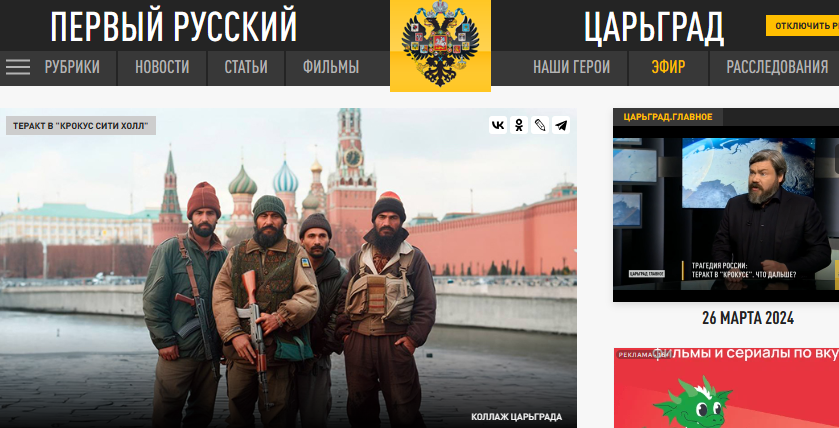
Home page of Tsargrad illustrated with a collage of armed Tajik fighters appearing to pose in front of the Kremlin; Konstantin Malofeev is pictured at upper right. For more on how Malofeev made his first fortune, click to read this and the archive.
Putin responded swiftly in his speech to prosecutors on Tuesday; the State Duma followed. “[Prosecutors should] consider implementing a system of additional preventive and anti-crime measures,” the president said, “including supervision of compliance with migration legislation. The situation in this area, which is very important and of great concern to millions of people, must be closely monitored.” The same day, Vyacheslav Volodin, the Duma Speaker, told a parliamentary session that he is appointing a multi-party working group “that will analyze the entire range of legislation that is relevant to the challenges of today, and legislation in the field of migration.”
Pro-US reporters in Moscow reverse the direction of the crackdown Malofeev and his supporters advocate. “Russians will likely face the security crackdown that, ironically [sic], they have largely avoided over two years of war in Ukraine. That would mean a further tightening of the screws on speech and make it much harder to use public transportation or gather in large groups. Communities of migrant workers will likely face a real crackdown… the tactics once adopted to deal with terrorists became quickly accepted as a new norm to treat political dissent. Thus the torture the Russian security services used against four suspects might be used against all sort of people in the country. This is the most direct consequence of the attack.”
Malofeev and the Tsargrad group are not alone in saying the Crocus City Hall attack should lead to intensification of the military operations in the Ukraine. “They struck at us, at our civilians, moreover, in the very center of our Homeland. This is an act of war. It needs to be answered as we have said many times. It must finally be answered with the massive real use of weapons that will allow us to win this war. We must give the civilian population [in the Ukraine] 48 hours to leave the cities and then strike with all our might. Then the war will end quickly, which means that the sponsorship of terrorist attacks will stop. No Americans and British, without the Armed Forces of Ukraine, without Kiev, without the current war, will sponsor terrorist attacks on the territory of Russia.”
For the time being, there has been no impact of the Crocus attack and the Moscow media debate on the operational or strategic plans under way in the Ukraine. The intensification of the General Staff’s offensive along the line of contact in the Donbass; in the electric war against Kharkov and other cities east of the Dnieper River; and in the missile attacks on targets from Kiev to Lvov – reported here — commenced before the Moscow events; they are continuing as planned.
“Those in political command who have been favouring an outcome to the war that falls short of regime change in Kiev and extension of demilitarization to the Polish border,” observes a Moscow political source, “have lost their voice since Saturday night.”


